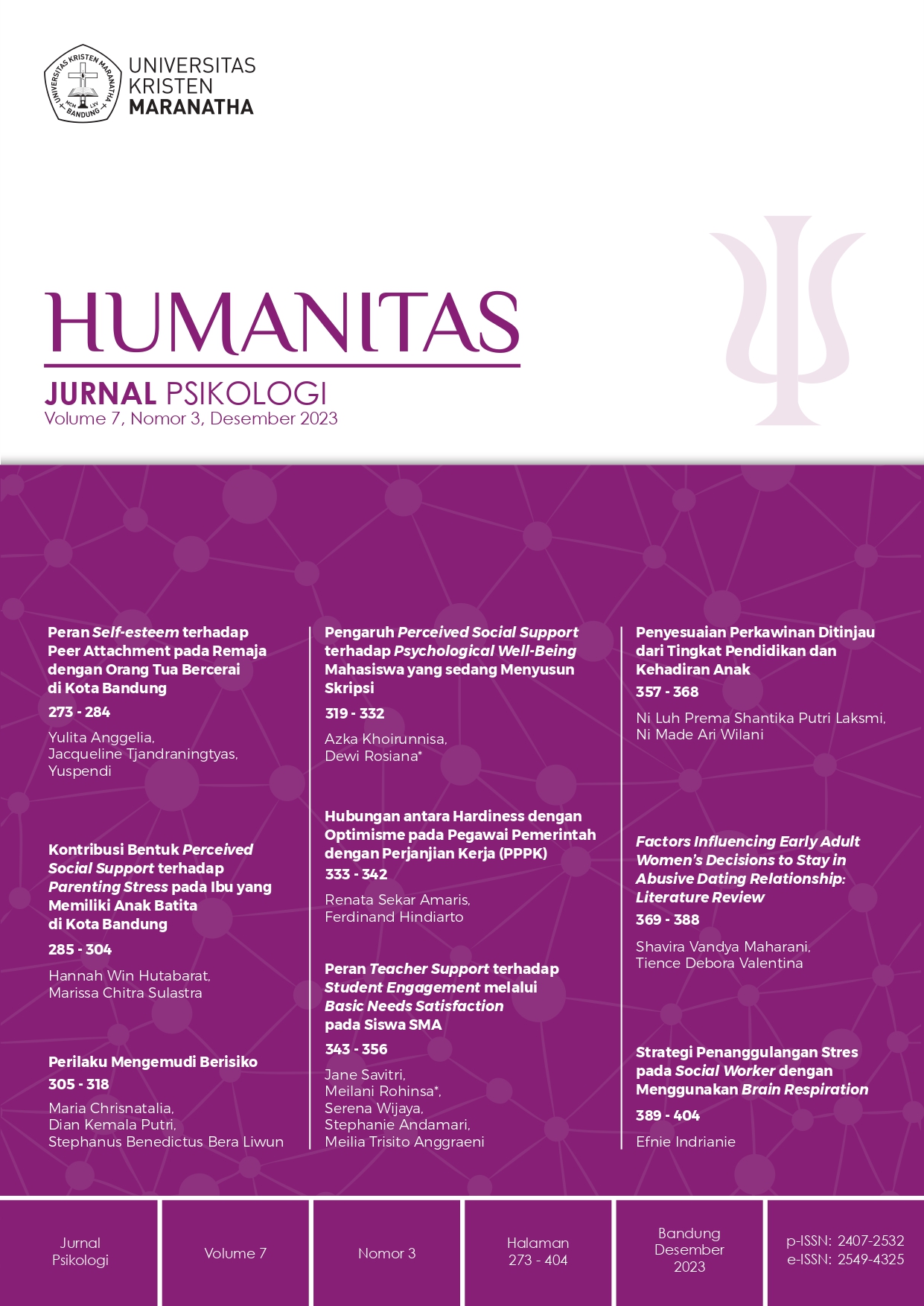Risky Driving Behavior
Main Article Content
Abstract
Downloads
Article Details

This work is licensed under a Creative Commons Attribution-NonCommercial 4.0 International License.
References
Bagaskara, S. (2017). Perbandingan perilaku mengemudi berisiko antara pengemudi mobil dan pengendara sepeda motor dan kaitannya dengan faktor-faktor kepribadian. In Jurnal Transportasi (Vol. 17, Issue 2).
Biro Komunikasi dan Informasi Publik. (2023, September 19). Tekan angka kecelakaan lalu lintas, kemenhub ajak masyarakat beralih ke transportasi umum dan utamakan keselamatan berkendara. Https://Www.Dephub.Go.Id/. https://www.dephub.go.id/post/read/%E2%80%8Btekan-angka-kecelakaan-lalu-lintas,-kemenhub-ajak-masyarakat-beralih-ke-transportasi-umum-dan-utamakan-keselamatan-berkendara
Dahlen, E. R., & White, R. P. (2006). The Big Five factors , sensation seeking , and driving anger in the prediction of unsafe driving I. 41, 903–915. https://doi.org/10.1016/j.paid.2006.03.016
Darmawan Hangkawidjaja, A., Analya, P., & Adelina, I. (2023). Implementasi Perangkat Lunak Attention Distraction Test. Humanitas, 7(2), 163–178.
De, J. L., Lynch, R. S., Oetting, E. R., & Yingling, D. A. (2001). Driving anger : correlates and a test of state-trait theory. 31, 1321–1331.
Deery, H. A., & Fildes, B. N. (1999). Young Novice Driver Subtypes : Relationship to High-Risk Behavior , Traffic Accident Record , and Simulator Driving Performance. 41(4), 628–643.
Deffenbacher, J. L., Deffenbacher, D. M., Lynch, R. S., & Richards, T. L. (2003). Anger , aggression , and risky behavior : a comparison of high. 41, 701–718. https://doi.org/10.1016/S0005-7967(02)00046-3
Deffenbacher, J. L., Oetting, E. R., & Lynch, R. S. (1994). Development of a driving anger scale. Psychological Reports, 74(1), 83–91. https://doi.org/10.2466/pr0.1994.74.1.83
Dula, C. S., & Geller, E. S. (2003). Risky , aggressive , or emotional driving : Addressing the need for consistent communication in research. 34, 559–566. https://doi.org/10.1016/j.jsr.2003.03.004
Editors. (2022, January 21). Teen Drivers: how to reduce the risk. morrisbart.com. https://www-morrisbart-com.translate.goog/blog/teen-driver-risk/?_x_tr_sl=en&_x_tr_tl=id&_x_tr_hl=id&_x_tr_pto=tc
Iversen, H., & Rundmo, T. (2004). Attitudes towards traffic safety, driving behaviour and accident involvement among the Norwegian public. Ergonomics, 47(5), 555–572. https://doi.org/10.1080/00140130410001658709
Lucidi, F., Mallia, L., Lazuras, L., & Violani, C. (2014). Personality and attitudes as predictors of risky driving among older drivers. Accident Analysis and Prevention, 72, 318–324. https://doi.org/10.1016/j.aap.2014.07.022
Maciej, J., Nitsch, M., & Vollrath, M. (2011). Conversing while driving : The importance of visual information for conversation modulation. Transportation Research Part F: Psychology and Behaviour, 14(6), 512–524. https://doi.org/10.1016/j.trf.2011.05.001
Miyajima, B. C., Nishiwaki, Y., Ozawa, K., Wakita, T., Itou, K., Takeda, K., & Itakura, F. (2007). Driver Modeling Based on Driving Behavior and Its Evaluation in Driver Identification.
Neubauer, C., Matthews, G., & Saxby, D. (2012). The effects of cell phone use and automation on driver performance and subjective state in simulated driving. Proceedings of the Human Factors and Ergonomics Society, 1987–1991. https://doi.org/10.1177/1071181312561415
Novanto, R., & Prayogi, G. (2023, March 27). Populasi kendaraan bermotor di RI capai 154 juta unit, 59 persen ada di pulau Jawa. Kumparan.Com. https://kumparan.com/kumparanoto/populasi-kendaraan-bermotor-ri-capai-154-juta-unit-59-persen-ada-di-pulau-jawa-205yy0ebekF/full
Staf, H., Studi, P., Sipil, T., Bengkulu, U., & Kandang, R. (2009). Hubungan tingkat emosional dengan perilaku pengemudi dalam berlalu lintas. 1(1), 23–30.
Susanto, N., Suliantoro, H., & Tindaon, U. A. (n.d.-b). Analisis performansi dan perilaku mengemudi dengan menggunakan gadget secara hand-held dan hands-free. 1–12.
Triman, A., Bagaskara, S., & Kunci, K. (2017). Peran Trait Kepribadian terhadap Perilaku Mengemudi Pengendara Bermotor di Jakarta The Role of Personality Trait to the Driving Behavior in Motorcycle Rider in Jakarta. 5(2).
Ulleberg, P., & Rundmo, T. (2003). Personality, attitudes and risk perception as predictors of risky driving behaviour among young drivers. Safety Science, 41(5), 427–443. https://doi.org/10.1016/S0925-7535(01)00077-7

